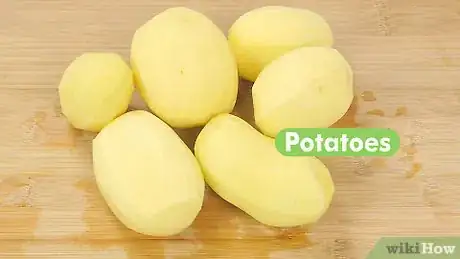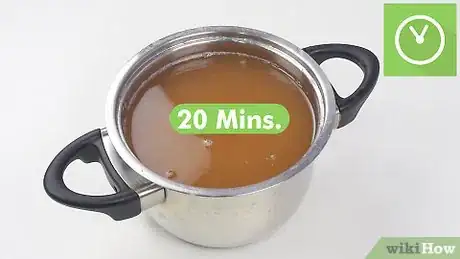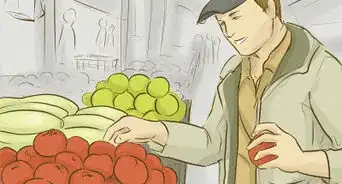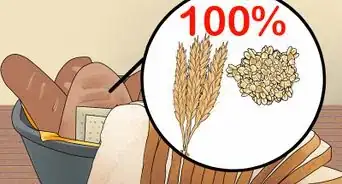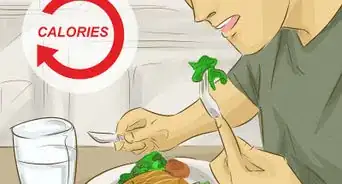This article was co-authored by Claudia Carberry, RD, MS. Claudia Carberry is a Registered Dietitian specializing in kidney transplants and counseling patients for weight loss at the University of Arkansas for Medical Sciences. She is a member of the Arkansas Academy of Nutrition and Dietetics. Claudia received her MS in Nutrition from the University of Tennessee Knoxville in 2010.
This article has been viewed 107,056 times.
Potato starch is used in many recipes as a thickener. If you run out, you can always reach for cornstarch, which is a common substitute. However, you may not have cornstarch either. In this case (or if the store is out of cornstarch), you will have to make your own. The process does take some time, but it may help you in a pinch.
Ingredients
- 6 medium-sized potatoes
- 3 to 4 cups (700 to 950 milliliters) warm water (plus extra)
Makes ¼ cup (40 grams) potato starch
Steps
Preparing the Potatoes
-
1Clean and peel the potatoes. Scrub the potatoes clean first using warm water and a scrubby brush. Peel them using your preferred method or tool, then cut away any leftover eyes.[1]
-
2Grate the potatoes. You can do this by hand using the small holes on a box grater. You can also use the grating attachment on a food processor instead.Advertisement
-
3Cover the potatoes with warm water. Scoop the grated potatoes into a pot, then cover them with warm water. How much water you end up using will vary, but about 3 to 4 cups (700 to 950 milliliters) should be enough.[2]
- If you used a food processor, you may notice some white stuff in the bowl. This is some of your starch. Swirl some water in the bowl to loosen the starch, then add it to the potatoes.[3]
-
4Strain the potatoes, reserving the water. Place a strainer or colander onto another pot. Line it with cheese cloth, then pour the grated potatoes into it. Bundle the potatoes up in the cheese cloth, then squeeze it to get as much water out as possible.[4]
-
5Repeat the watering and straining process until the water runs clear. Place the potatoes back into the empty pot. Cover them with more warm water, then pour them back into the cheesecloth-lined strainer or colander. Squeeze the cheesecloth to drain more water. Keep repeating this step until the water runs mostly clear.[5]
-
6Save the strained water and set the grated potatoes aside. You only need the strained potato water to make the starch. You do whatever you want with the grated potatoes, such as using them to make hash browns. If you won't use them right away, cover them with water, add a squirt of lemon juice, and keep them in the fridge.[6]
Extracting the Starch
-
1Allow the starch to settle for about 20 minutes. As time goes on, the water will start to turn clear-ish again. The starch will settle at the bottom of the pot.[7]
- The water may take on a brown or orange tint. This is perfectly fine.
-
2Pour out the excess water. The starch will be mostly stuck to the bottom of the pot, so you shouldn't have to worry about it as you pour the water out. Still, avoid stirring or sloshing the water around as much as possible. Discard this excess water, or use it in a soup or sauce.[8]
- If you are having trouble with this step, you can scoop the water out with a soup ladle instead.
-
3Add fresh water to the container and wait another 20 minutes or so. Pour some more water into the container (try to use the same amount that you poured out). Let the starch settle to the bottom, another 20 minutes.[9]
- This fresh water will clean the sludge.
-
4Pour the water off and save the starch. Use the same technique as you did the first time. Once again, be careful not to mix the starch into the water.[10]
-
5Use the wet starch, if desired. You can use the wet starch as-is to thicken sauces, soups, and stews. You can also read on to the next section to learn how to dry it out.[11]
- Wet starch is easier to mix into sauces, soups, and stews because it is already hydrated.
Drying the Starch
-
1Spread the starch out onto a baking sheet with a rubber spatula. You can also use a wide baking pan or casserole dish. The thinner you spread the starch, the faster it will dry.[12]
- You can also use a dehydrator instead. Line the dehydrator with the "fruit roll up" tray so that you don't lose the starch.[13]
-
2Allow the starch to dry and harden. You can cover the starch with a sheet of paper, wax paper, or parchment paper if you want to Avoid using plastic wrap, however, or you will trap the moisture. It can take up to 24 hours for the starch to dry, depending on how thick or thin it is.[14]
- If you are using a dehydrator, set it to low, about 105 to 115°F (40 to 46°C). Allow the starch to dry. Depending on your dehydrator, this can take several hours.[15]
-
3Break the dried starch up. You can do this with your fingers, a fork, a whisk, or even a spoon. Don't worry about getting all of the clumps out; the next step will fix that.
-
4Grind the starch into a powder. It is best to do this in a clean coffee grinder, but you can try a food processor or blender as well. This will break up any remaining clumps and make it fine and powdery, just like the kind you'd get in a store.[16]
-
5Store the potato starch in a small jar. Roll a sheet of paper into a cone, and stick it down the neck of a small, glass jar, such as a spice jar. Pour the potato starch into the jar, then remove the paper and close the jar.
- Keep the jar tightly sealed in a cool, dry place.
- The potato starch should last up to six months.
Expert Q&A
-
QuestionWhich foods are high in resistant starch?
 Claudia Carberry, RD, MSClaudia Carberry is a Registered Dietitian specializing in kidney transplants and counseling patients for weight loss at the University of Arkansas for Medical Sciences. She is a member of the Arkansas Academy of Nutrition and Dietetics. Claudia received her MS in Nutrition from the University of Tennessee Knoxville in 2010.
Claudia Carberry, RD, MSClaudia Carberry is a Registered Dietitian specializing in kidney transplants and counseling patients for weight loss at the University of Arkansas for Medical Sciences. She is a member of the Arkansas Academy of Nutrition and Dietetics. Claudia received her MS in Nutrition from the University of Tennessee Knoxville in 2010.
Master's Degree, Nutrition, University of Tennessee Knoxville Master's Degree, Nutrition, University of Tennessee KnoxvilleExpert AnswerFoods such as slightly green bananas, potatoes (and sweet potatoes), and corn contain resistant starch.
Master's Degree, Nutrition, University of Tennessee KnoxvilleExpert AnswerFoods such as slightly green bananas, potatoes (and sweet potatoes), and corn contain resistant starch. -
QuestionDo sweet potatoes have resistant starch?
 Claudia Carberry, RD, MSClaudia Carberry is a Registered Dietitian specializing in kidney transplants and counseling patients for weight loss at the University of Arkansas for Medical Sciences. She is a member of the Arkansas Academy of Nutrition and Dietetics. Claudia received her MS in Nutrition from the University of Tennessee Knoxville in 2010.
Claudia Carberry, RD, MSClaudia Carberry is a Registered Dietitian specializing in kidney transplants and counseling patients for weight loss at the University of Arkansas for Medical Sciences. She is a member of the Arkansas Academy of Nutrition and Dietetics. Claudia received her MS in Nutrition from the University of Tennessee Knoxville in 2010.
Master's Degree, Nutrition, University of Tennessee Knoxville Master's Degree, Nutrition, University of Tennessee KnoxvilleExpert AnswerYes, sweet potatoes are a good source of resistant starch. Avoid adding too much butter or sugar to sweet potatoes.
Master's Degree, Nutrition, University of Tennessee KnoxvilleExpert AnswerYes, sweet potatoes are a good source of resistant starch. Avoid adding too much butter or sugar to sweet potatoes.
Things You'll Need
- Knife
- Vegetable peeler
- Food processor or grater
- Colander or strainer
- Cheesecloth
- Few pots
- Tray or dehydrator
- Small glass jar
- Coffee grinder or food processor (optional)
References
- ↑ https://www.youtube.com/watch?v=R269seUJpIQ
- ↑ http://www.pennilessparenting.com/2015/06/making-homemade-potato-starch-tapioca.html
- ↑ https://www.youtube.com/watch?v=R269seUJpIQ
- ↑ https://www.youtube.com/watch?v=R269seUJpIQ
- ↑ https://www.youtube.com/watch?v=R269seUJpIQ
- ↑ https://www.youtube.com/watch?v=R269seUJpIQ
- ↑ http://www.pennilessparenting.com/2015/06/making-homemade-potato-starch-tapioca.html
- ↑ http://www.pennilessparenting.com/2015/06/making-homemade-potato-starch-tapioca.html
- ↑ http://www.pennilessparenting.com/2015/06/making-homemade-potato-starch-tapioca.html
- ↑ http://www.pennilessparenting.com/2015/06/making-homemade-potato-starch-tapioca.html
- ↑ http://www.pennilessparenting.com/2015/06/making-homemade-potato-starch-tapioca.html
- ↑ http://www.pennilessparenting.com/2015/06/making-homemade-potato-starch-tapioca.html
- ↑ https://www.youtube.com/watch?v=R269seUJpIQ
- ↑ http://www.pennilessparenting.com/2015/06/making-homemade-potato-starch-tapioca.html
- ↑ https://www.youtube.com/watch?v=R269seUJpIQ
- ↑ http://www.pennilessparenting.com/2015/06/making-homemade-potato-starch-tapioca.html
- ↑ http://www.cooksinfo.com/potato-starch
- ↑ http://www.cooksinfo.com/potato-starch
- ↑ http://www.pennilessparenting.com/2015/06/making-homemade-potato-starch-tapioca.html
